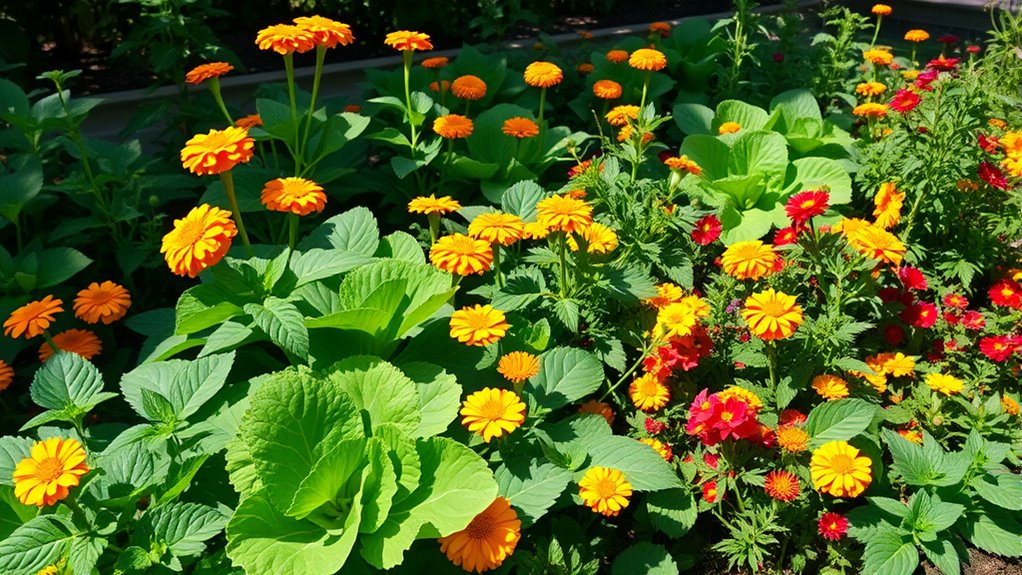To naturally repel insects, try planting basil near tomatoes to deter aphids and whiteflies, or marigolds around vegetables to protect against nematodes and aphids. Nasturtiums help guard cabbage crops from worms, and chives can fend off carrot flies. Herbs like mint and lavender also disrupt pest behavior. Combining these plant pairs creates a balanced, pest-resistant garden. Keep exploring to discover more effective companion strategies for a healthy, insect-free harvest.
Key Takeaways
- Plant basil near tomatoes to naturally repel aphids, whiteflies, and spider mites, reducing the need for chemical pesticides.
- Use marigolds around vegetable beds to deter nematodes, aphids, and attract pollinators, enhancing pest control and soil health.
- Incorporate lavender nearby fruit trees to repel moths and mites, attracting beneficial pollinators and creating pest barriers.
- Grow nasturtiums with cabbage family crops to repel cabbage worms and serve as trap crops for pests.
- Combine mint with melon crops to disrupt ant and squash bug behavior, reducing pest infestations naturally.
Basil and Tomato: A Natural Pest Deterrent

Planting basil near tomatoes can substantially reduce pest problems, making it a popular natural pest deterrent. This is a classic example of companion planting, where two plants enhance each other’s growth and protection. Basil’s aromatic leaves repel common tomato pests like aphids, whiteflies, and spider mites, improving pest control without chemicals. When you grow basil alongside tomatoes, you’re creating an environment less attractive to harmful insects, reducing the need for pesticides. This natural pest control method benefits your garden’s health and your harvest quality. Plus, basil’s flavor complements tomatoes perfectly, making it a win-win. Incorporating basil into your planting scheme is simple, effective, and eco-friendly, helping you maintain a healthier garden ecosystem while naturally warding off pests. Additionally, essential oils for pest control can be used as a natural repellent in gardening practices.
Marigolds and Vegetables: Keeping Nematodes and Aphids at Bay
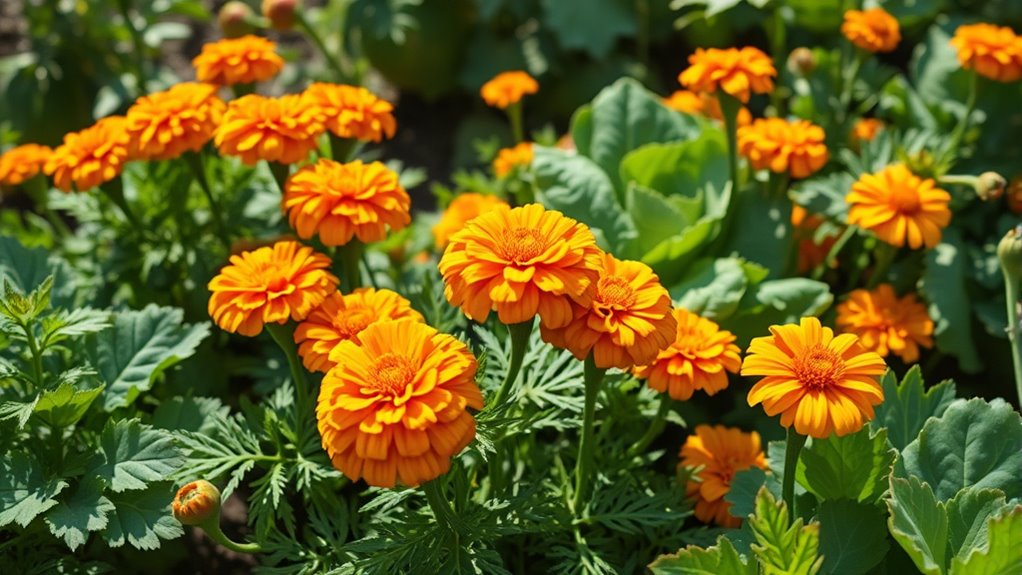
Have you ever considered how marigolds can protect your vegetable garden? These vibrant flowers repel nematodes, improving soil health by reducing harmful pests that can damage roots. Planting marigolds around your vegetables creates a natural barrier, helping to keep aphids at bay and preventing infestations. Plus, marigolds attract pollinators like bees, which boost your garden’s productivity. Their strong scent confuses pests and discourages them from settling on your crops. By integrating marigolds into your planting scheme, you enhance soil robustness and foster a healthier environment for your vegetables. Linguistic variations and the cultural significance of companion planting highlight the importance of understanding diverse gardening traditions. The combination of pest deterrence and pollinator attraction makes marigolds a valuable companion plant that supports a thriving, balanced garden ecosystem.
Nasturtiums and Cabbage Family Crops: Protecting Against Cabbage Worms
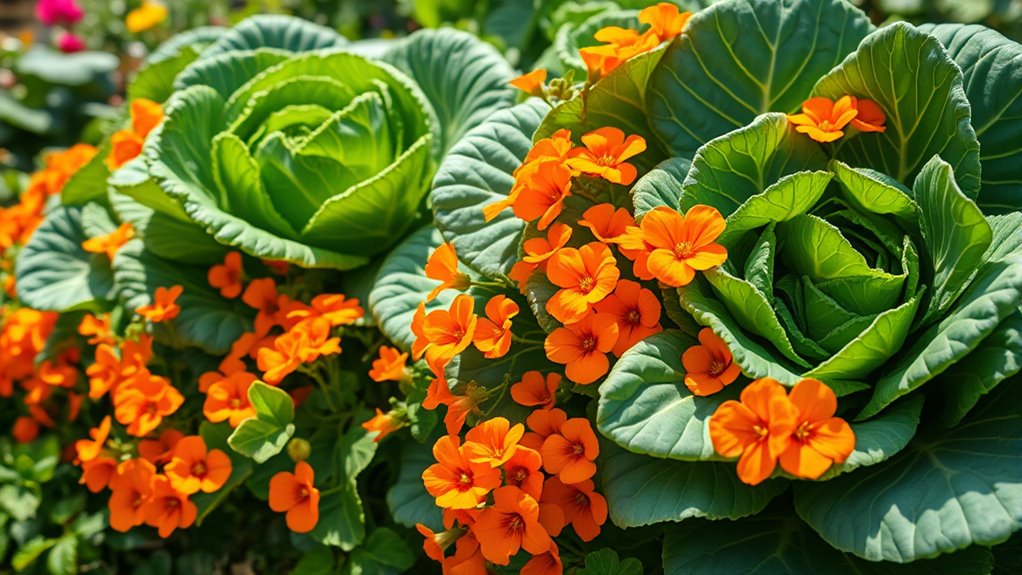
Nasturtiums act as natural repellents, drawing cabbage worms away from your crops. Planting them alongside cabbage family vegetables can reduce pest damage effectively. Discover how companion planting with nasturtiums offers simple, eco-friendly protection for your garden.
Nasturtiums as Natural Repellent
Because nasturtiums emit strong, distinctive aromas, they serve as an effective natural repellent for cabbage worms. Their scent disrupts pest attraction, enhancing companion dynamics by creating a protective barrier around cabbage family crops. When you plant nasturtiums nearby, they help increase pest resistance by discouraging these pests from settling on your vegetables. The strong aroma acts as a natural deterrent, reducing the need for chemical controls. Incorporating nasturtiums into your garden not only benefits the health of your plants but also promotes a balanced ecosystem. As a companion plant, nasturtiums provide a dual purpose: attracting beneficial insects and repelling harmful pests. This makes them an essential component of an integrated pest management strategy, supporting healthier, pest-resistant crops. Additionally, understanding the contrast ratio of your garden lighting can help optimize plant growth and pest control effectiveness.
Cabbage Worm Deterrence Strategies
Wondering how to effectively protect your cabbage family crops from pesky worms? Companion planting offers a smart pest management solution. Planting nasturtiums near your cabbages and broccoli creates a natural barrier that deters cabbage worms. These vibrant flowers emit scents that confuse or repel the pests, reducing their likelihood of laying eggs on your crops. Additionally, interplanting with herbs like dill or cilantro can further discourage cabbage worm infestations. Regularly inspecting your plants and removing eggs or larvae also boosts your pest management efforts. By strategically combining these companion plants, you create an environment less inviting to worms, minimizing damage and reducing the need for chemical controls. This approach keeps your crops healthy and pest-free naturally.
Companion Planting Benefits
Integrating nasturtiums into your garden offers a powerful natural defense against cabbage worms when planted near your cabbage family crops. These vibrant flowers act as a trap crop, attracting pests away from your vegetables. Additionally, nasturtiums promote pollination enhancement by drawing beneficial insects that improve crop yields. They also enrich the soil by adding organic matter when their leaves decompose, supporting healthy plant growth. The benefits extend beyond pest control, creating a more resilient garden ecosystem.
- Attracts beneficial insects that prey on pests
- Acts as a visual pest barrier
- Improves soil health through organic matter
- Supports pollination, increasing vegetable productivity
Chives and Carrots: Repelling Carrot Flies and Aphids
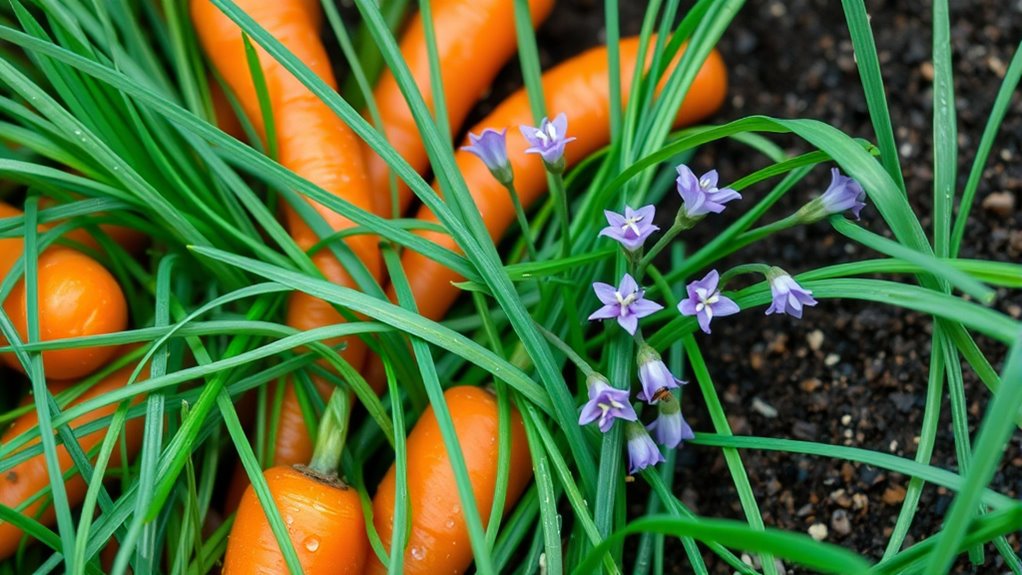
Planting chives near carrots can considerably reduce problems caused by carrot flies and aphids. This simple companion planting technique enhances pest control naturally, protecting your crops without chemicals. Chives emit a strong aroma that deters pests, making them an effective partner for carrots. To maximize benefits, consider planting chives around your carrot bed or interspersed within rows. Additionally, garden design principles suggest that strategic placement can improve pest resistance and overall garden health.
| Pest | How Chives Help |
|---|---|
| Carrot flies | Repel with strong scent |
| Aphids | Deter by confusing pests |
| Other pests (e.g., thrips) | Provide additional pest resistance |
| Companion planting tips | Space chives for ideal pest control |
Using chives as a companion plant creates a natural pest barrier, making your garden healthier and more productive.
Mint and Melons: Discouraging Ants and Squash Bugs

Just as chives can help keep pests away from carrots, mint offers similar benefits when grown near melons. Herb interplanting with mint can disrupt insect behavior, making it less likely for ants and squash bugs to settle. The strong aroma of mint confuses these insects’ scent trails and deters them from approaching your melons. Additionally, mint’s presence can create a natural barrier, reducing the need for chemical controls. This simple companion planting strategy not only protects your crops but also promotes a healthier garden ecosystem. To maximize effectiveness, plant mint near melon vines early in the season. Keep in mind that mint spreads quickly, so container-growing or controlled planting is best to prevent overgrowth. This method provides a natural, pest-repellent solution rooted in understanding insect behavior. With ongoing advancements in natural pest control, incorporating herbs like mint aligns with sustainable gardening practices that minimize chemical use and support ecosystem health.
Lavender and Fruit Trees: Fending Off Moths and Mites
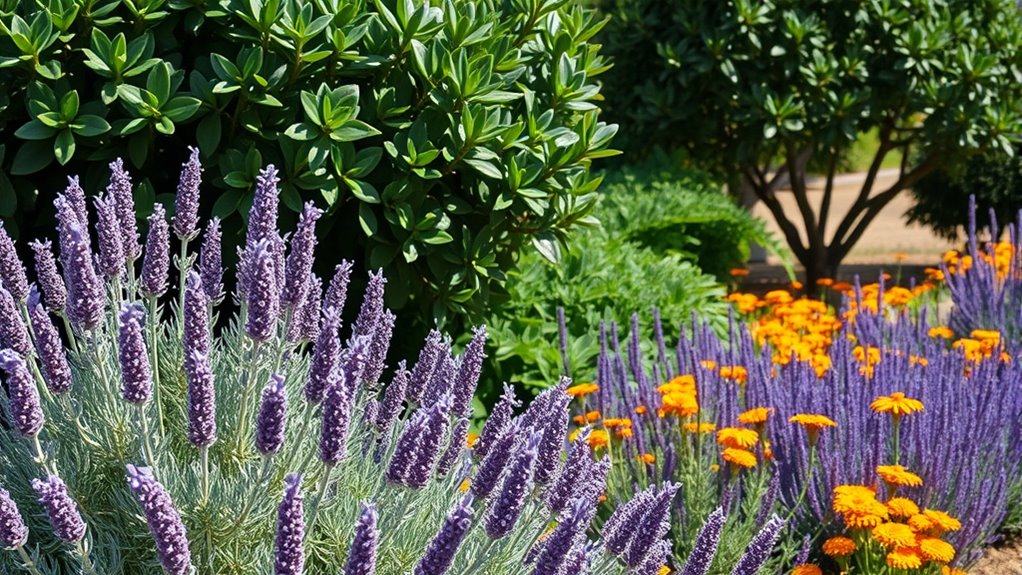
Lavender’s strong scent naturally repels moths and mites, making it a great addition near your fruit trees. By planting lavender close by, you can help protect your trees without using chemicals. This simple pairing keeps pests at bay while adding beauty to your garden. Additionally, incorporating tuning techniques can optimize plant health and growth, much like enhancing engine performance in vehicles.
Lavender’s Pest Repellent Qualities
Lavender is renowned for its ability to repel pests, making it a valuable companion for fruit trees. Its strong scent deters moths, mites, and other insects that threaten your harvest. You can enhance pest control strategies by using lavender essential oil, which releases a potent aroma that insects dislike. Planting lavender nearby creates a natural barrier, reducing the need for chemical pesticides. The scent also confuses pests, preventing them from finding your fruit trees easily. Additionally, lavender’s pest-repelling qualities can help protect vulnerable blossoms and fruit. Incorporating lavender into your garden not only adds beauty but also provides a natural pest control solution. Its pest-repelling qualities make it an essential ally in maintaining healthy, insect-free fruit trees. This natural approach aligns with the importance of insect-repellent plants in sustainable gardening practices.
Protecting Fruit Trees Naturally
Are moths and mites threatening your fruit trees despite your efforts? You can naturally protect them by planting lavender nearby. Lavender’s fragrant aroma repels these pests while attracting pollinators that boost fruit production. This dual role enhances pollinator attraction, ensuring healthy fruit development. Additionally, lavender improves soil enrichment, promoting strong root systems that help trees resist infestations. Regularly planting lavender around your fruit trees creates a protective barrier without chemicals. Its natural insect-repellent properties keep moths and mites at bay while supporting beneficial insects. Plus, lavender’s soil benefits contribute to overall tree health. Incorporating companion planting strategies can maximize pest control and foster a balanced ecosystem that defends your fruit trees naturally and sustainably.
Borage and Strawberries: Deterring Slugs and Aphids
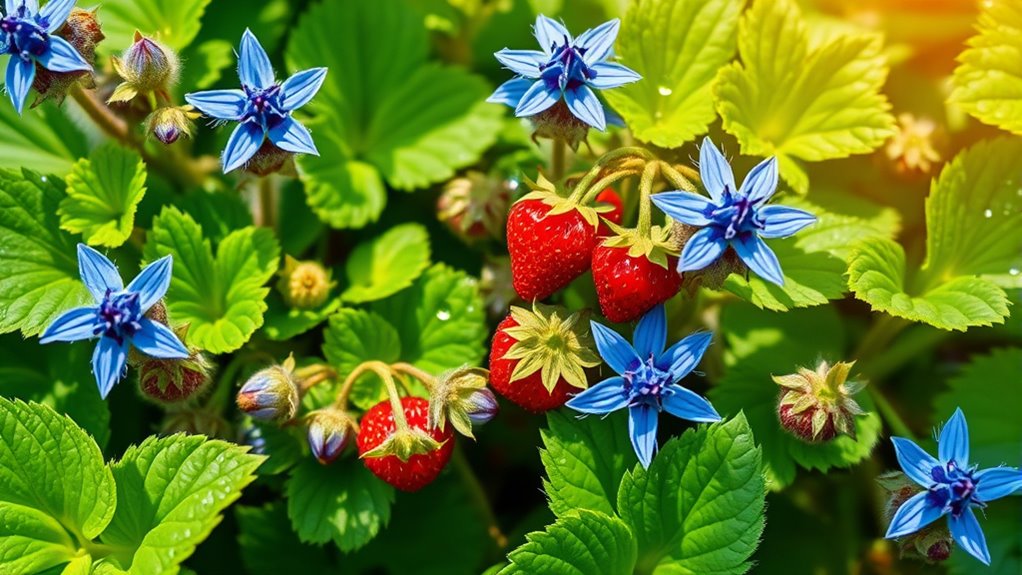
Because borage emits strong scents that insects find unappealing, planting it near strawberries can help keep slugs and aphids at bay. Borage not only deters pests but also attracts pollinators, boosting fruit production. Its presence improves soil health by adding trace minerals, which benefits your strawberries. By pairing these plants, you create a natural pest barrier that supports a healthier garden ecosystem. You’ll notice fewer pest problems and more vibrant, productive strawberry plants. Plus, borage’s ability to attract pollinators ensures better fruit set and overall garden vitality. This pairing offers a simple, effective way to protect your strawberries without chemicals, making your garden both healthier and more productive. Incorporating sound vibrations into your gardening practices can further enhance plant health and resilience.
Petunias and Vegetables: Scaring Off Tomato Hornworms
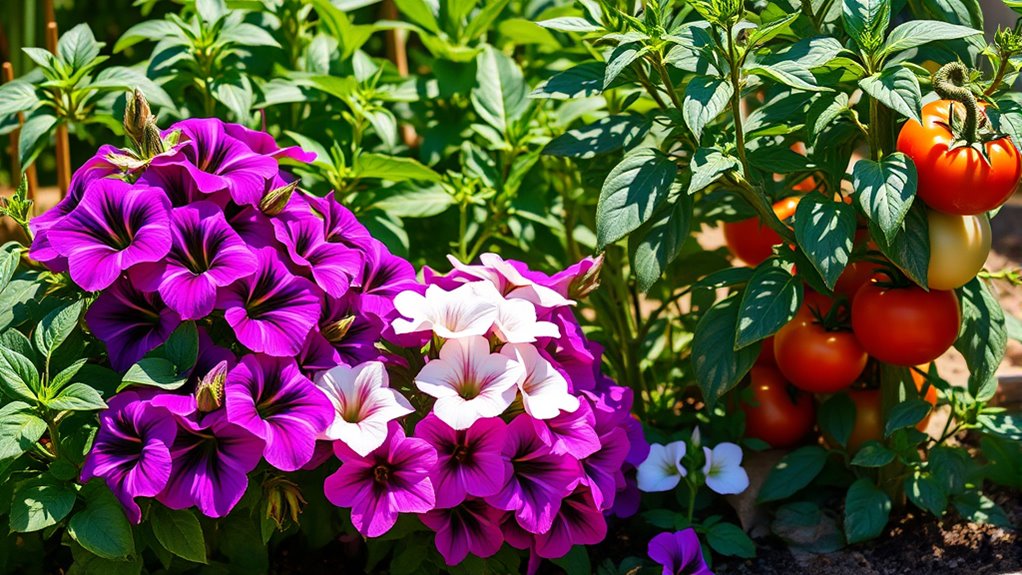
Planting petunias near your vegetable garden can effectively deter tomato hornworms, which are notorious for damaging tomato plants. Petunias emit scents that repel these pests, providing a natural insect barrier. Besides scaring off hornworms, petunias attract pollinators, enhancing pollination for your vegetables. This boost in pollination can lead to better fruit production and healthier plants. Additionally, petunias contribute to soil nutrition by adding organic matter as they decompose, enriching the soil around your garden. Their vibrant blooms also improve soil health through their root systems. By incorporating petunias into your garden, you not only protect your vegetables from pests but also promote pollination efficiency and improve soil quality, creating a balanced ecosystem that supports vigorous plant growth and higher yields. Moreover, understanding companion planting strategies can help you select the most effective plant combinations for pest control and overall garden health.
Frequently Asked Questions
Can Companion Planting Reduce the Need for Chemical Pesticides?
Yes, companion planting can reduce your need for chemical pesticides. By using natural pest repellents through strategic plant combinations, you create a barrier that deters pests effectively. Following specific companion planting schedules enhances this protection, promoting healthier plants and reducing chemical use. You’ll find your garden more resilient and eco-friendly, as these natural methods work together to keep pests at bay without harming beneficial insects or the environment.
Are These Plant Combinations Effective in All Climates?
You wonder if these plant combinations work everywhere. Their climate adaptability varies, so regional effectiveness depends on your local environment. Some companion plants repel insects well in certain climates but may not perform as effectively elsewhere. To maximize insect-repelling benefits, consider your area’s specific conditions and choose plant pairings suited to your region. This approach helps guarantee you get the best results from your companion planting efforts.
How Long Does It Take to See Pest Control Benefits?
You might find it takes a little patience to notice pest resistance improvements, often around a few weeks to a couple of months. As you enhance plant diversity, natural pest deterrents gradually build up, creating a more resilient garden. Consistent companion planting encourages beneficial insects and confuses pests, leading to better protection over time. Keep in mind, environmental factors can influence how quickly these positive effects become visible.
Can Companion Planting Improve Crop Yields Besides Pest Control?
Companion planting can definitely boost your crop yields beyond just pest control. By attracting pollinators, your plants get better fertilization, leading to more abundant produce. Additionally, certain companion plants enrich the soil with nutrients, improving overall plant health and growth. You’ll notice healthier, more vigorous crops as a result. So, incorporating strategic plant combinations not only keeps pests at bay but also enhances pollinator attraction and soil enrichment, maximizing your harvest potential.
Are There Any Plants That Should Not Be Planted Together?
Poor plant pairing can cause conflicts and crop chaos in your garden. You should avoid planting incompatible companions that may compete for nutrients or attract pests, undermining pest deterrent strategies. For example, don’t pair beans with onions, as their plant compatibility is poor and they might hinder each other’s growth. Keep pest problems and plant conflicts in check by choosing compatible plants that work well together, promoting healthy, harmonious harvests.
Conclusion
By planting these companion combinations, you’ll turn your garden into an unstoppable insect-fighting fortress. Imagine a world where pests flee at the mere sight of your vibrant blooms and fragrant herbs—your garden becomes an invincible army against bugs! With these natural allies, you’ll outsmart even the craftiest pests, ensuring your plants thrive and flourish like never before. Get ready to witness your garden’s transformation into an insect-free paradise—nature’s ultimate bug-busting revolution!
